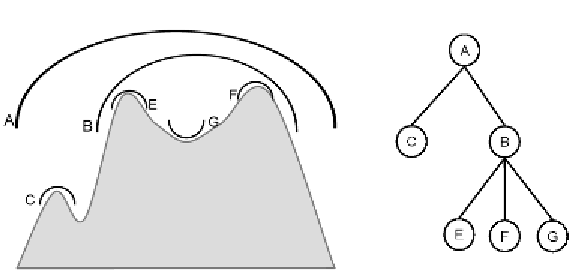Geoscience Reference
In-Depth Information
Figure 6:
Feature representation and its corresponding feature tree
Two kinds of features are considered in this research: features correspond-
ing to higher areas (peaks) characterized by a set of contours where
contours on the boundary are deeper than all inner contours, and features
corresponding to deeper areas (pits), characterized by boundary contours
shallower than all inner contours. On
Figure 6
, the peak A contains two
peaks B and C and peak B contains two peaks E and F and one pit G.
These features are identified from the contour tree on
Figure 5
, right. A
third kind of feature may appear in the feature tree which is a mixed fea-
ture, that is, a feature whose boundary contour is neither the highest or the
lowest. Such feature always contains some descendants which can be
described as peaks and pits.
4.2 The multi-agent model
4.2.1 Agent description
In this project, agents are divided into two levels: macro agent and micro
agent. The agents with higher level contain lower level agents. Macro
agent can activate daughter features and contours. Macro agents represent
terrain features. Micro agents are the contour lines. As the features are
organized in a hierarchy based on inclusion, a contour line can belong to
different features. Generalizing one feature implies that its children features
are also generalized. Therefore, in its life cycle, a feature will activate all
its children features in order to generalize common contours. For example,
in
Figure 7
, all contours belong to a large peak A. L3 also belongs to peak

